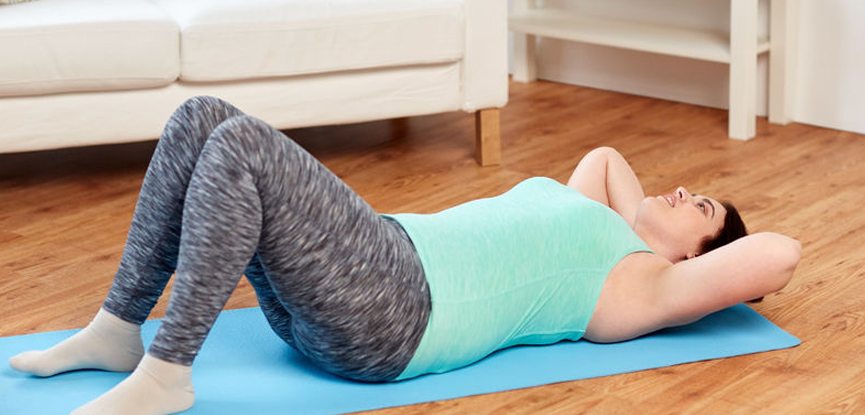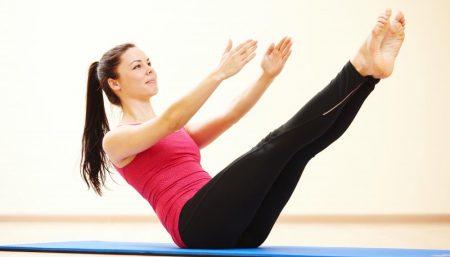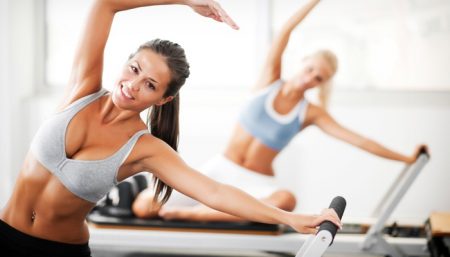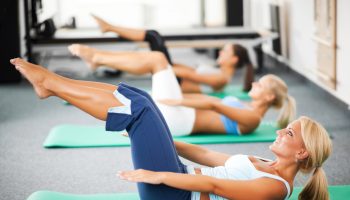Pilates in increasingly overweight women assists in developing heightened body awareness and a new ability to listen to one’s body and let that voice be the authentic guide when it comes to good nutrition and movement.

Improved orthopedic health is another benefit that a Pilates program offers to the overweight individual. Without proper orthopedic health, the client may be unable to progress to cardiovascular work. Many Pilates exercises are similar to those designed by physical therapists for rehabilitating people with low-back problems. A study of 22 adults conducted at Florida Atlantic University found that a 12-week Pilates program reduced back pain (Graves et al. 2005).
The transversus abdominis needs to be “turned on” in plus-size clients to provide stability and to support the lumbar pelvic girdle.
There is no doubt that each of the Pilates exercises need to be modified for the obese client.
6 Principles To Be Applied For Overweight & Obese Women By A Coach
Centering. Movements originate from the center of the body—the powerhouse—located between the lower ribs and the pubic bone. In the overweight client, there may be mass covering the pubic bone, even in a prone position. Initially, therefore, it might be a challenge for the client to “find center,” but visualization should help her make the connection. This can be a good time to introduce the location of internal organs in the body. Empower your overweight client with the knowledge and kinesthetic wisdom of where the stomach, liver and kidneys are located. Centering, paired with visualization, may eventually allow the other five principles to occur.
Concentration. At first, concentration may be incredibly challenging for the overweight client. This client is generally not connected to her body, so encouraging full-body awareness can be frustrating, overwhelming and overloading to the central nervous system. Begin by asking your client to be aware of the moving body part. If that is too much, ask her to become aware of what is working in her body. In the beginning it may be nothing, or she may feel nothing. If so, break the question down even more. Try asking, “Is there one molecule engaged/working in this exercise?” Slowly the central nervous system will get on track, as well as the client’s ability to arrive fully in her body, one molecule at a time.

Control. Initially, control may be interesting to monitor. The overweight body is amazing in its ability to adapt. It compensates by engaging different muscle groups to perform an action instead of using the appropriate biomechanics and firing the accurate muscles. Teach your client awareness so that she isn’t “muscling” movements, but instead is using control and exertion specific to the action.
Precision. While precision is important, it may be more beneficial to focus on what is working for the client rather than what is not working. When you build on the positives, step by step, the body and mind begin to work in sync. Until your client gains a better grasp of the work, too much detail may be overwhelming. You must understand how the client learns best—kinesthetically, auditorily or visually. A kinesthetic or visual person may not integrate auditory cues. Use a blend of all of the approaches, notice which ones resonate with the client, focus on what is working and refine precision from there.
Breath. Many Pilates instructors teach very full breathing, using the lungs as “bellows.” Most Pilates moves coordinate with the breath, and it is a key aspect of the practice. Teach your client how to palpate the collarbone and lower ribs to help her “feel” the breath. Touching the bones, even deep behind the flesh, will let her sense the lungs’ potential to expand. As with internal organs, bringing awareness to the location and capacity of the lungs is empowering. Also, your obese client may have been told to “suck it in” on the inhalation, so natural diaphragmatic breathing may need to be re-established within the body.
Flow. The overweight person tends to hurl her body through space without being aware of the “how” involved in locomotion. Using Pilates equipment can help your client find flow in movement, which may be different from her experience in day-to-day living. Explain that even the space between one movement and another can flow seamlessly. Teaching the concept of flow will add a sense of grace to a body that often feels cumbersome and weighted down. Simple observation by the client can facilitate curiosity and acceptance in a once fearful body and allow for the possibility of safe, flowing, precise movement.

Joint integrity is weak in the knees, hips, lumbar spine and shoulders in overweight women. Therefore, strength is needed to help the muscles hold the joints properly. Building strength in the knees, hips and lumbar spine will bolster alignment, allowing the client to move on to other activities.
For more input: www.ideafit.com
Disclaimer
The Content is not intended to be a substitute for professional medical advice, diagnosis, or treatment. Always seek the advice of your physician or other qualified health provider with any questions you may have regarding a medical condition.



